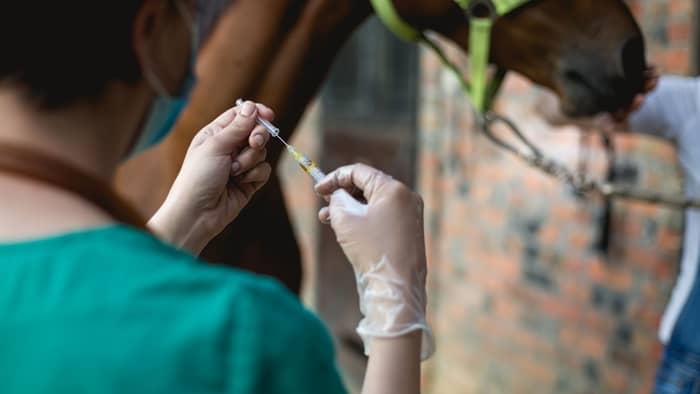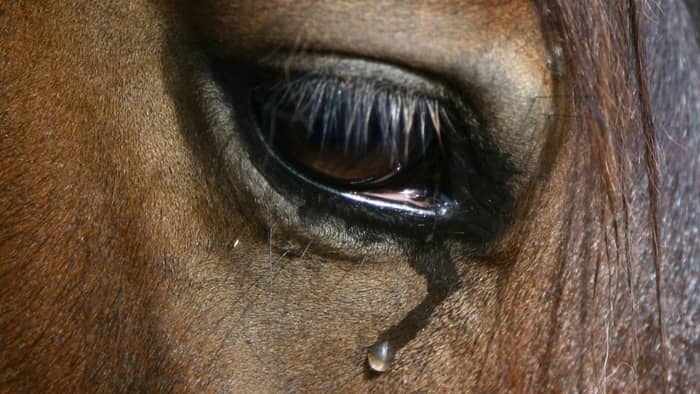Last Updated on January 12, 2022
Although it is not something that we like to think about, at some point your horse’s life will come to an end. You may need to make the difficult decision to have your horse euthanized to relieve them from suffering. But what does this process involve, and what do vets use to euthanize horses?
Today we will look at all aspects of horse euthanasia to help you through this difficult time.
Why Is Putting A Horse Down Necessary?
If you become a horse owner, at some point you may need to make some difficult decisions, such as whether it is necessary to have your horse put down. This is not an easy decision to make, and the thought of losing your equine best friend can be heartbreaking. However, in many situations, it is the best thing to do for your horse.
The main reason that horses are euthanized is to relieve them from pain and suffering. This could be because of a long-term illness that is deteriorating, or because of an incurable injury. It may also be that your horse is very old and no longer has a good quality of life.
Sadly, other reasons for euthanizing a horse are not always as straightforward. It may be that you have financial considerations to take into account. For example, your horse may have a long-term medical condition that is too expensive to treat.
Occasionally a horse may be euthanized because it has behavioral problems. For example, it may too dangerous to handle or need to be confined to a stall at all times. This can be a hard decision to make, but when considering the horse’s quality of life it is normally the right thing to do.
What Do Vets Use To Euthanize Horses?

When you are thinking about having your horse put down, you might be worried about what the process actually involves. It can be very daunting if you have never seen a horse being euthanized before. However, the more you know about what to expect, the easier it will be.
Vets use one of two methods to euthanize horses. The first of these is to use lethal injection, and the second is a gun or captive bolt.
-
Lethal injection
Lethal injection is the favored method of euthanasia for many horse owners. It is seen as less violent than a gun, and many feel that it is more gentle.
This euthanasia method involves giving the horse an intravenous injection of a combination of a tranquilizer and a barbiturate. This combination firstly makes the horse unconscious and then stops the heart. It is common practice to administer a sedative before the lethal injection takes place.
Whilst this method is preferable from the horse owner’s point of view, it can make disposing of the carcass quite problematic. The drugs contained in the lethal injection are toxic to all other mammals. This means that it cannot enter the food chain, even for pet food, and must not be scavenged by wild animals.
-
Gun or captive bolt
The second method of horse euthanasia is by gun or captive bolt. The horse is euthanized using a firearm by shooting a certain point of the skull from close range. This is a dangerous procedure and must only be carried out by a highly skilled and experienced professional.
Whilst the use of a firearm may sound very violent to a horse owner, the horse will die instantly and will not feel any pain. The main advantage of this method is that it makes disposal of the carcass much easier.
Goodbye Old Friend: The Euthanasia of Your Horse
How Are Horses Euthanized?
If you’ve been present when a cat or dog was euthanized, it is likely that you were allowed to stay with them during the whole process. Is the same case with a horse?
Unfortunately, with a horse, it is unlikely that euthanasia will be as calm and gentle. This is because, once unconscious, the horse will quickly fall from a standing position to the ground. And, as well planned as the procedure is, they do not always fall gently!
Also, if a firearm is to be used, the operator will want the bare minimum number of people in the vicinity.
Most horse owners choose to stay with their horse while the initial sedative injection is administered. You can stay while they become sleepy, and no longer know that you are there. At this point, it is normally a good idea to leave the actual euthanasia in the hands of the professionals.
Horse Euthanize – Factors To Consider
One thing that can make having a horse euthanized much easier is to have an end-of-life plan.
This means that you think about when, where, and how, you will have your horse euthanized when the time comes. Making an end-of-life plan can help reduce the need to make difficult decisions during an already stressful time. You should think about what would happen during preplanned euthanasia plus an emergency scenario.
To make your horse’s end-of-life plan, think about the following factors:
- Where will euthanasia take place? It should be somewhere where the horse is calm and relaxed, but also where the body can be easily removed after euthanasia. Many owners choose to carry out this procedure in the field.
- Who will be there when the horse is euthanized? Think about who might like to say goodbye to the horse beforehand.
- How will the body be disposed of? Have the contact number ready for your local horse disposal service, or a plan in place if the horse is to be buried at home.
- Do you want to keep anything to remember your horse by? Some people like to take a lock of mane or tailor the horse’s shoes. Others opt to have the horse individually cremated and the ashes returned in a casket.
Summary

So, as we have learned, veterinarians have two methods of euthanasia available for horses. The first of these is using a gun or captive bolt, and the second is by lethal injection. The method that vets choose to use to euthanize horses will be decided on a case-by-case basis.
We know that this is a difficult subject to think about, and we hope that any worries have been cleared up within this article. If you have any questions about what vets use to euthanize horses leave a comment below and we’ll get back to you.

Kate Chalmers is a qualified veterinary nurse who has specialized in horse care for the vast majority of her career. She has been around horses since she was a child, starting out riding ponies and helping out at the local stables before going on to college to study Horse Care & Management. She has backed and trained many horses during her lifetime and competed in various equestrian sports at different levels.
After Kate qualified as a veterinary nurse, she provided nursing care to the patients of a large equine veterinary hospital for many years. She then went on to teach horse care and veterinary nursing at one of the top colleges in the country. This has led to an in-depth knowledge of the care needs of horses and their various medical ailments, as well as a life-long passion for educating horse owners on how to provide the best possible care for their four-legged friends.
Kate Chalmers BSc (Hons) CVN, Dip AVN (Equine) Dip HE CVN EVN VN A1 PGCE
